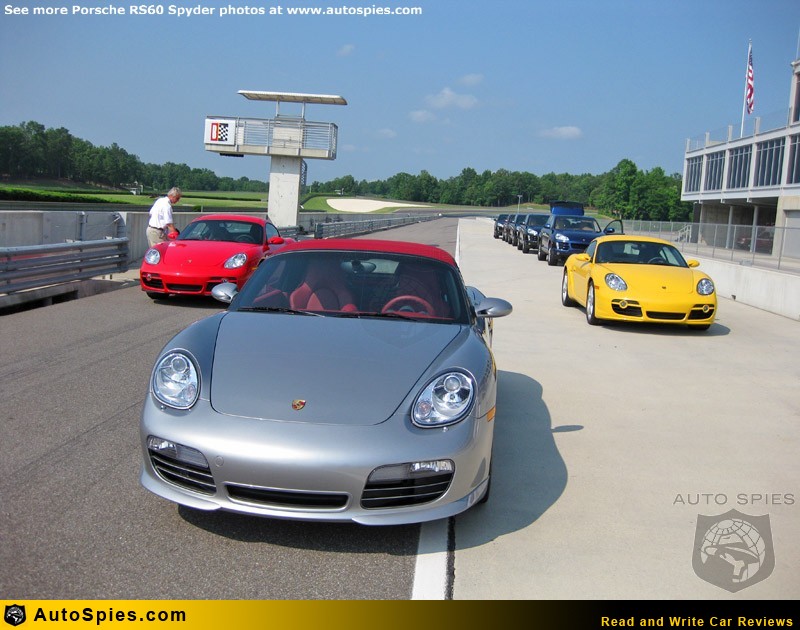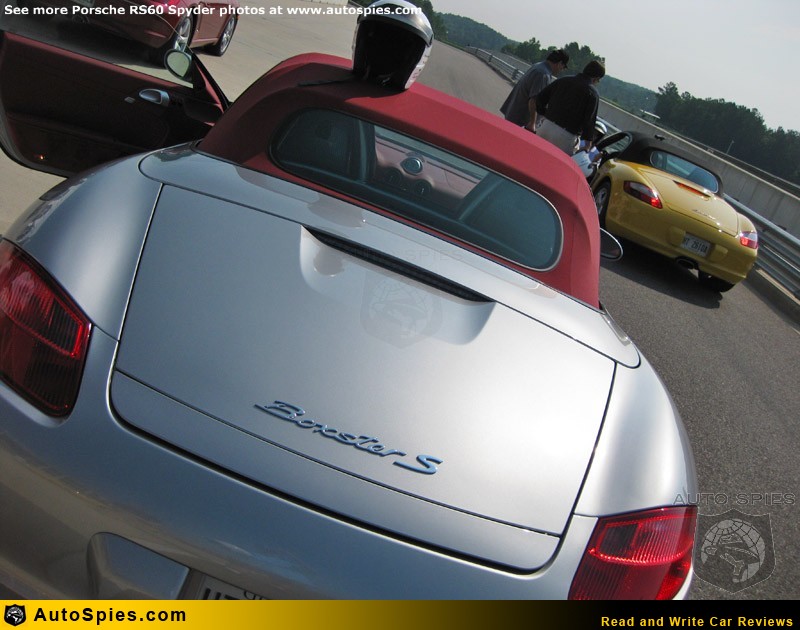Despite their many distinct differences, the Porsche Boxster and Boxster S roadsters, and the Cayman and Cayman S coupes share a critical and core characteristic: All are mid-engine. Engineers and designers of the world's highest-echelon open-wheel race cars agree that a mid-engine configuration is unsurpassed for an optimally balanced chassis. Porsche's engineers and designers wholeheartedly concur.
By placing the engines of these four cars directly behind their two-seat cockpits but ahead of their rear drive wheels, Porsche's engineers have created affordable sports cars that reward their enthusiast drivers with outstanding road holding, agility and response.
A suspension to optimize the architecture
Porsche's engineers developed a fully independent suspension for the mid-engine configuration. This ensures that regardless of the driver's skill level, each of these mid-engine sports cars will perform competently and confidently.
Though tuned specifically for each car, the Boxster, Boxster S, Cayman and Cayman S all boast a race-proven front suspension which consists of spring-strut axles with separately mounted longitudinal and track control arms to assure precise wheel guidance while controlling body roll. In the rear, these two seaters each have specifically tuned versions of Porsche's spring-strut rear suspension with longitudinal and track control arms.
Stability, regardless of road surface, is further enhanced by Porsche Stability Management (PSM) which is standard equipment on all four. PSM is a computerized system that relies on data from an assortment of sensors to help maintain the car's intended path as the driver pushes it to the edges of its dynamic limits.
Like all Porsche vehicles, these four sports cars boast four-wheel disc, antilock brakes. All four discs are cross-drilled and vented internally for optimum performance even under long periods of hard use. Those drivers of the Boxster S and Cayman S who desire even greater braking power than standard may opt for Porsche Ceramic Composite Brakes (PCCB).

Distinctive models
Their mid-engine layout aside, the Boxster, Boxster S, Cayman and Cayman S are clearly separate and individual cars.
The Boxster and Boxster S are two-place roadsters created to accommodate two people and a modicum of cargo in a small, agile, open-top, and powerful sports car. Unlike other roadsters with manual folding tops, the soft-top of the Boxster and Boxster S is power operated at the touch of a button. And since Porsche engineers understand full well that conditions can change suddenly, the top can be operated even as the car is moving at speeds up to approximately 40 mph.
The Cayman and Cayman S coupes are slightly longer, nose to tail, than the Boxster roadsters and slightly taller. More critically, the coupes' steel-roofs give those cars a structure that's 100 percent more resistant to flex than the already superbly stiff Boxster roadster.
Besides offering larger, more powerful engines than their siblings, both the Boxster S and Cayman S come equipped with larger wheels, tires and brakes than the non-S variants.
While both roadster and coupe share a family resemblance when viewed head on, the Cayman's stunningly long and unique sloping roof slides down between voluptuous rear fenders, presenting a parting view that's unique in the world.
The shapes of all four cars are deeply rooted in efficient aerodynamics. When equipped with manual gearbox, the Boxster and Cayman boast a coefficient of drag of only 0.29. This efficiency benefits the driver with improved fuel economy and a quieter, more stable ride at high speeds.

Two different clean and potent engines
All four cars are powered by a Porsche hallmark: a horizontally opposed six-cylinder engine.
The 2008 Boxster and Cayman carry a 245-horsepower 2.7-liter powerplant. The engine develops 201 lb.-ft. of torque.
The more-potent Boxster S and Cayman S are propelled by a 3.4-liter flat six-cylinder that produces 295 horsepower and 251 lb.-ft. of torque.
All four cars may be equipped with either a six-manual gearbox or Porsche's driver-shiftable five-speed Tiptronic S automatic transmission.
All the engines are equipped with Porsche's VarioCam Plus adjustable intake-valve timing and lift system, and Motronic sequential fuel injection. This means that both Boxster and Cayman are certified as Ultra Low Emissions Vehicles (ULEV), while the Boxster S and Cayman S earn a LEV-II (Low Emissions Vehicles, category two) rating. And despite each of the cars' awesome performance potential, none comes with the stigma of a gas-guzzler penalty.
For 2008 models, the recommended oil change interval is now 12,000 miles (20,000 km), or one year. The spark plugs should be replaced every 36,000 miles (60,000 km), or four years.

Open-top and closed-top occupant protection
All Boxsters and Caymans are equipped with three-point inertia-reel seat belts with belt-latch tensioners and belt-force limiters as well as six airbags. In addition to two-stage frontal airbags, the cars feature the Porsche Side Impact Protection (POSIP) system with torso-protecting thorax side-impact airbags mounted in the outer edges of the seatbacks and special head-protecting side-impact airbags which deploy from the doors' windowsills.
The frontal airbags benefit from the use of an organic-based propellant which reduces their needed storage space and their weight, while also easing their recyclability. To protect small children, the passenger seat sensors automatically defeat the passenger front airbags if the sensors detect a light-weight occupant.
No spare needed
Porsche's engineers know that correct inflation pressures are not just critical for safety, fuel economy and long tire life, but also are mandatory for exacting the full measure of a car's dynamics.
Therefore all four cars come equipped with Porsche's Tire Pressure Monitoring System (TPMS) as standard equipment. To save 22 pounds (10 kg) and increase room for cargo, the Boxster and Boxster S, and the Cayman and Cayman S are equipped with an electric air compressor and emergency tire sealant. There is no spare tire, jack or tire-changing tools.
More performance for those who want it
Those drivers who desire even greater agility can opt for Porsche Active Suspension Management (PASM) which is available on all four mid-engine models. PASM offers the driver a choice of two basic damper settings, Normal and Sport, and automatically and continuously adopts to the driver's style. At the core of PASM are continuously adjustable dampers, a front and rear accelerometer and a dedicated electronic control unit.
Still crisper handling performance along with enhanced engine, transmission and suspension response can be had with Porsche's optional Sport Chrono Package Plus. This feature is available on all four models and allows more aggressive control maps for the engine speed limiter, Porsche Stability Management (PSM), and for the optional Porsche Active Suspension Management (PASM), and Tiptronic S. The feature is activated by pressing a button on the center console. The package also includes a separate stopwatch gauge on top of the instrument panel.
Plethora of options
All models can be further tailored to an individual driver's taste through the selection of the various options.
At the head of the list is the enhanced Porsche Communication Management (PCM). This boasts a DVD-based navigation system. The navigation system features twenty-three stages of map magnification from a minimum resolution of 55 yards (50 meters). Information is displayed on a 5.8-inch color monitor.
Newly available for 2008 are optional leather sports bucket seats. Essentially race seats with folding backrests, the new sports bucket seats boast carbon fiber-reinforced construction for a weight savings of 15 to 20 pounds (7 to 9 kg) over standard seats, depending on model. Like all Porsche driver and front-passenger seats, the sports bucket seats have integrated thorax airbags and are compliant with all U.S. safety standards.
Other options include a seven-speaker, 180-watt Porsche Sound Package Plus with an external amplifier as well as a325-watt Bose Surround System with a seven-channel digital amplifier and eleven speakers. Bi-Xenon® headlamps and Park Assist that uses ultrasound to measure the distance to the nearest obstacle and warns the driver as needed are also available.
Check out 001's Awesome Porsche Boxster and Cayman Gallery!